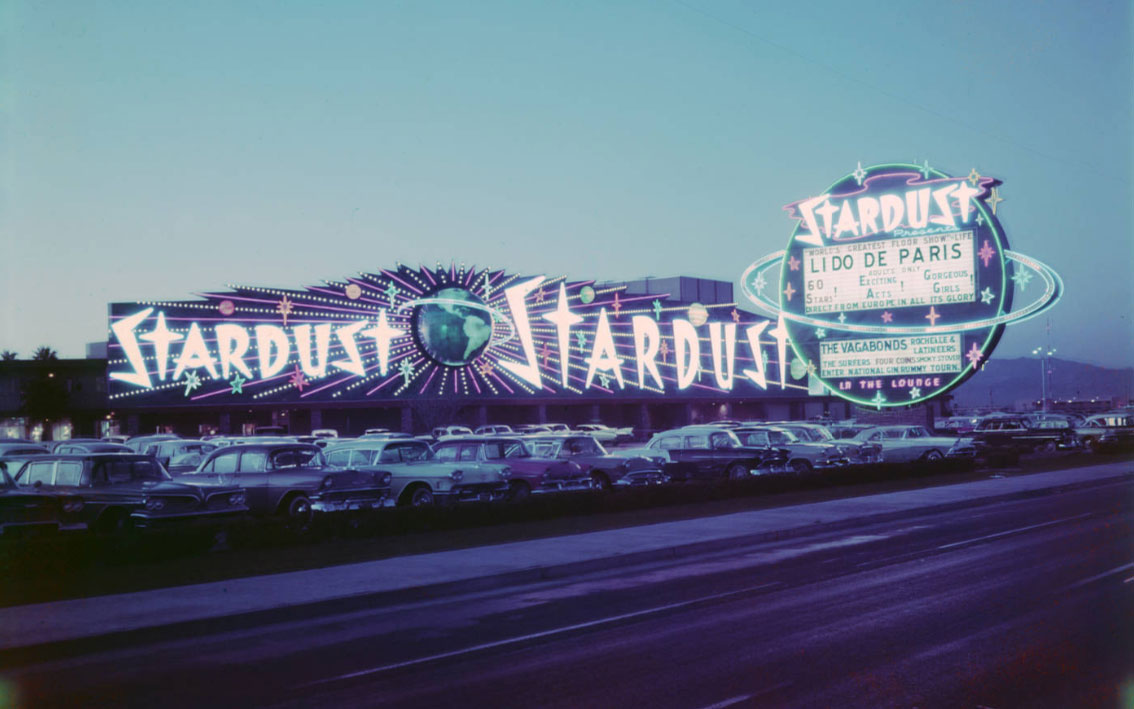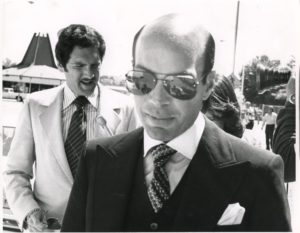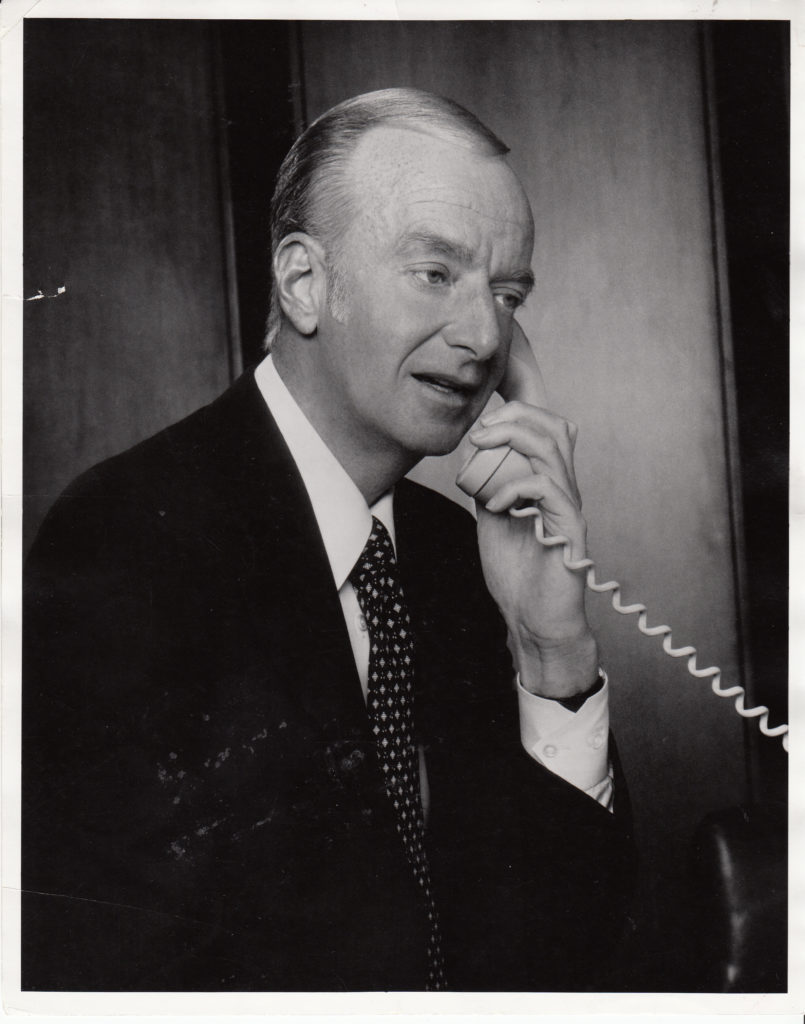The Stardust Hotel, longtime cash cow for the Mob, debuted 60 years ago on the Las Vegas Strip
Midwest crime syndicates skimmed millions from resort, a scheme that inspired the movie Casino

One of the Las Vegas Strip’s most iconic casino resorts opened 60 years ago today. The Stardust was renowned for its neon signage and topless showgirls – and notorious for its underworld connections.
Tony Cornero first conceived of the Stardust in the early 1950s. It would be the crowning achievement he sought following a checkered past in the casino business. Cornero, whose family moved to the United States from northern Italy when he was a child, had a long history in Las Vegas. He was fresh out of federal prison when Nevada legalized commercial gambling in 1931. Cornero had done well for himself in the rum-running business in Southern California during Prohibition, but ran afoul of Uncle Sam on bootlegging charges. While he was in prison, his brothers, Louis and Frank, opened the Meadows Club, an ahead-of-its-time hotel-casino – with a band stage and elegant furnishings — far from the hustle and bustle of the lowbrow gambling joints on downtown’s Fremont Street.
Located just outside the city limits where Fremont Street merges into Boulder Highway, the Meadows brought a touch of glamour to the desert, and might have been a model for self-contained casinos far from the urban core. But the Cornero brothers struggled as owners. When a fire erupted in the casino, the Las Vegas Fire Department refused to battle the blaze because the Meadows was located outside the city limits. Left with a hotel and a burned-out casino building, the Corneros sold their interest in the property.
In 1938, Tony began operating offshore gambling ships in Southern California, including one dubbed the S.S. Rex. Locals nicknamed him “The Admiral” for running his floating casinos. While his ships spelled success for Cornero – he reportedly took in $6 million a year – California law prohibited casino gambling. He maintained that since his vessels were three miles out to sea, state and federal laws did not apply. But California Governor Earl Warren felt differently. So did the U.S. Supreme Court, which ruled that his casino ships operated in state waters.
Cornero returned to Las Vegas in 1944 to join some partners in a small casino, the S.S. Rex, at the Apache Hotel on Fremont Street. But after a falling out with his partners, Cornero left the S.S. Rex in 1946. That year, back in Southern California, he launched another casino ship off Long Beach, but the U.S. Coast Guard seized it, ending his nautical efforts there. In 1948, while meeting at his home in Beverly Hills with potential investors in a casino project in Mexico, a supposed deliveryman appeared at the door and shot Cornero in the abdomen. Though critically wounded, he recovered, but the Mexican deal fell through.
Cornero, still optimistic, turned his eyes back to Las Vegas, this time with a dream of building the world’s biggest casino, the Stardust.
The Securities and Exchange Commission, along with his penchant for high-stakes craps-playing, impeded but never stopped Cornero’s progress. Construction of the Stardust, planned to have 1,000 hotel rooms, was well on its way in 1955. But the Nevada Gaming Commission, seeing Cornero’s background as unsuitable, refused to grant him a gaming license. So he inked a deal with investors headed by former Los Angeles illegal gambler Milton B. “Farmer” Page to lease the Stardust’s hotel and casino for an unheard-of $500,000 per month.
But fate soon turned away from Cornero again. On July 31, 1955, he gambled away $37,000 on a craps table at the Desert Inn. While in a heated argument with a casino dealer over a $25 chip, Cornero suffered a massive heart attack and fell dead “before he hit the floor,” the coroner later stated. Construction of the Stardust was nearly three-quarters complete.
John “Jake the Barber” Factor, brother of cosmetics giant Max Factor and a man who was reportedly not a stranger to the Chicago Outfit, purchased the still-unfinished Stardust and brought in Moe Dalitz and the management of the Desert Inn to run the casino.
The Stardust opened in a blaze of fireworks on July 2, 1958. With its 1,000 guest rooms, it was bigger than any hotel previously opened in Las Vegas. Size, rather than style, was the hotel’s most prominent feature. Its 16,000-square-foot casino was immense for its time, and the 140-foot bar that ran along much of its east wall was the forerunner of The D’s present-day Longbar in downtown Las Vegas.
But the real star of the Stardust at its opening was the Lido de Paris, the first topless French revue production staged in Las Vegas. Producer Donn Arden became renowned both for the technical complexity of the Lido – the stage mounted on six hydraulic lifts that could raise and lower it as the drama demanded – and the beauty of the costumed showgirls.
With its hotel rooms sprawling to the back in two-story wings, the Stardust’s chief roadside visual impact was its brightly lit sign — a 216-foot-long universe of celestial bodies joined by a round Earth circled by a satellite. The sign was a record-setter, as was the 105-foot-long Big Dipper pool.
Dalitz and his associates ran a profitable casino with the help of manager Johnny Drew. The Desert Inn crew remained lessees of Factor and his associates until 1965, when they became the owners of the property. Three years later, Howard Hughes attempted unsuccessfully to buy the Stardust. Having already bought the Desert Inn from Dalitz, the eccentric billionaire wanted to own what was, at the time, the state’s biggest casino. However, the Justice Department’s antitrust division halted what they thought would be an unfair concentration of casino ownership.
Throughout the 1960s, the Stardust expanded. It added a nine-story tower, bringing its total room count close to 1,500, and several new restaurants. The most fondly remembered were seafood restaurant Moby Dick and the Polynesian hotspot Aku Aku. Although both are now long gone, at least one piece of the Aku Aku survives. One of the two moai (stone statues) that graced the front of the restaurant stands on an island in the big lake at Sunset Park in Las Vegas.
Keno was another Stardust innovation of the 1960s. It had long been played in downtown casinos, but the Stardust, under manager Jerry Steinberg, brought it to the Strip in 1967.

In 1969, Dalitz sold the Stardust to the Parvin-Dohrmann Corporation, which five years later sold the casino to Allen Glick’s Argent Corporation.
If you’ve seen the movie Casino, you know the story — substitute “Stardust” for “Tangiers,” and you’ve got the gist of it. Glick, a previously obscure San Diego attorney and real estate developer, first bought the Hacienda Hotel on the Strip, and then the Fremont Hotel downtown and the Stardust. How did he do it? With about $100 million in loans from the Teamsters Central States Pension Fund.
Under Argent’s control, a former Chicago and Miami bookmaker named Frank “Lefty” Rosenthal became the de facto boss of the casino, even though he did not yet have a gaming license. Not everyone liked Rosenthal or his management style (the scene in Casino with the Rosenthal-based character Ace Rothstein obsessing over the number of blueberries in the coffee shop’s muffins wasn’t far from the truth). But Rosenthal was able to bring in enough big players that dealers saw their tips increase. That alone made him popular on the casino floor.
Another Rosenthal innovation, the sports book, would become one of the casino’s most celebrated elements until it closed. Reportedly, the pay phones outside the book were the highest grossing in the nation, as runners grabbed the nearest telephone to inform their out-of-state associates of the Stardust’s betting lines as soon as the book posted them. The “Stardust line” remained an industry standard until the very end.
While Rosenthal had the casino making money, he also supervised a slot and table game skimming operation that ultimately funneled millions to the Mob. In the early 1980s, federal investigators confirmed that since 1974, Stardust employees, working on behalf of several Midwestern Mob bosses, stole large amounts of cash from the Stardust and Fremont casinos.
In 1983, a federal grand jury indicted 15 people in a conspiracy to skim at least $1.6 million from the casinos’ table games, using phony paperwork. Those indicted included Joseph Aiuppa, head of the Chicago Outfit; Carl Civella, Mafia chief in Kansas City; and Milwaukee syndicate boss Frank Balistrieri.

Later, authorities charged mobsters in Cleveland with sharing in the stolen casino proceeds with the other Mob families. They estimated the four crime families took in $2 million from the Stardust alone.
Cleveland mobster turned witness Angelo Lonardo testified in federal court in 1985 that Milton Rockman, the Cleveland Mafia’s point man and his close friend, told him that mobsters in Milwaukee and Kansas City held sway over the Teamsters pension fund and tapped it to loan money to Glick to buy the Stardust. Lonardo stated that the Chicago, Kansas City, Milwaukee and Cleveland crime families each received from $40,000 and up to $100,000 per month from the Stardust skim, and that Cleveland Teamsters Union official William Presser, who was a pension fund trustee, got $1,500 a month.
Amid the allegations, Argent sold the Stardust to a group run by two veteran casino executives, Herb Tobman and Allan Sachs. While at first heralded as a new beginning for the Stardust, evidence of continued skimming surfaced, and the state forced Tobman and Sachs to relinquish control of the casino.
At the request of Nevada gaming regulators, the Boyd Group assumed the day-to-day operations of the Stardust. In 1985, Boyd bought both the Stardust and Fremont. Sachs and Tobman lost their gaming licenses and had to pay a $3 million fine.
As new owner, Boyd made several controversial changes in the Stardust. It replaced the famous Lido de Paris – which had inspired several imitators and gave a stage to young magicians Siegfried and Roy – with the less-revered stage show Enter the Night in 1992. While the resort’s 1967 sign, featuring a shower of stars, remained, Boyd replaced the midcentury futuristic lettering with a blocky typeface.
While the Stardust remained popular, it was never as profitable as the new casinos of the megaresort era. Boyd closed the property in 2006. Its ill-timed replacement resort, the Echelon hotel-casino, fell victim to the Great Recession and construction was halted. Boyd sold the Stardust site in 2013 to a Malaysian company, Genting Group, which plans to construct the Resorts World Las Vegas, a Chinese-themed megaresort, for an estimated $7.2 billion.
Although the future might see another casino rise on the land that once hosted the Stardust, the casino’s place in Las Vegas — and organized crime — history will never be overwritten.
David G. Schwartz, author of several books on Las Vegas gaming history, is director of the Center for Gaming Research and teaches history at the University of Nevada, Las Vegas.
Feedback or questions? Email blog@themobmuseum.org





